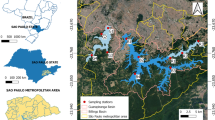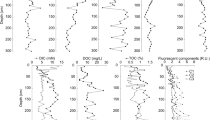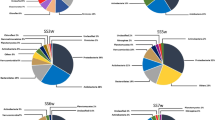Abstract
Microbial diversity and activities play pivotal biogeochemical roles in a redox-sensitive, pyrite-rich sediment’s ecosystem. However, very little is known about the microbial community composition and distribution among the redox zones of pyrite-rich sediment and their response to changes caused by the burial of the sediment beneath compacted fill. In the present work, culture-independent, molecular phylogenetic investigations of the prokaryotic population and its diversity in a naturally occurring pyrite-rich sediment were undertaken to determine the microbial community composition, richness, diversity and distributions among the varying redox zones and their functional response to the imposition of surface surcharge, in the form of compacted fill. It was established that the pyrite-rich sediment is a redox-sensitive environment consisting of microhabitats with distinct and discontinuous physico-chemical characteristics, including DO, pH, Eh, temperature, electrical conductivity and salinity. It is a favourable environment for cyclic transformation of inorganic sulphur compounds and a unique environment for the habitation and growth of various microorganisms. Microbes adapted to the microhabitat and lived together in consortia, in response to their physiological and functional requirements. Microbes involved in the sulphur cycle had their populations concentrated in the oxic zone, while those involved in iron and carbon cycles were prevalent in the anoxic zones. As a result, highly diverse microbial populations occurred in isolated peaks within the sediment. The physico-chemical differences within the sediment changed in response to changes in the sediment redox dynamics. Imposition of the surcharge resulted in significant changes in the pH, temperature, Eh, DO, EC and salinity, reflecting marked re-distribution of the microbial population within the ecosystem. The cable bacteria phenomenon was evident in the sediment studied; however, there were doubt regarding their filamentous occurrence.









Similar content being viewed by others
References
Abicht, H. K., Mancini, S., Karnachuk, O. V., & Solioz, M. (2011). Genome sequence of Desulfosporosinus sp. OT, an acidophilic sulfate-reducing bacterium from copper mining waste. in Norilsk, Northern Siberia. Journal of Bacteriology, 193, 6104–6105.
Appelo, C. A. J., & Postma, D. (2005). Geochemistry, Groundwater and Pollution, The Netherlands, A. A. Balkema Publishers.
Bjerg, J. T., Damgaard, L. R., Holm, S. A., Schramm, A., & Nielsen, L. P. (2016). Motility of electric cable bacteria. Applied and Environmental Microbiology, 82, 3816–3821.
Burton, E. D., Bush, R. T., Sullivan, L. A., Johnston, S. G., & Hocking, R. K. (2008). Mobility of arsenic and selected metals during re-flooding of iron- and organic-rich acid sulfate soil. Chemical Geology, 253, 64–73.
Chandler, A. P., & Gerson, A. R. (2010). The mechanism of pyrite oxidation and leaching: a fundamental perspective. Surface Science Reports, 65, 293–315.
Coates, J. D., Phillips, E. J. P., Lonergan, D. J., Jenter, H., & Lovley, D. R. (1996). Isolation of Geobacter species from diverse sedimentary environments. Applied and Environmental Microbiology, 62, 1531–1536.
Cook, F. J., Dobos, S. K., Carlin, G. D. & Millar, G. E. (2004). Oxidation rate of pyrite in acid sulfate soils: in situ measurements and modelling. Australian Journal of Soil Research, 42, 499–507.
Davison, W., Woof, C., & Rigg, E. (1982). The dynamics of iron and manganese in a seasonally anoxic lake; direct measurement of fluxes using sediment traps. Limnology and Oceanography, 27, 987–1003.
Dent, D. (1986). Acid sulphate soils: a baseline for research and development, Wageningen, The Netherlands, International Institute for Land Reclamation and Inprovement (ILRI).
Froelich, P. N., Klinkhammer, G. P., Bender, M. L., Luedtke, N. A., Heath, G. R., Cullen, D., & Dauphin, P. (1979). Early oxidation of organic matter in pelagic sediments of the eastern equatorial Atlantic: suboxic diagenesis. Geochimica et Cosmochimica Acta, 43.
Garbeva, P., Veen, J. A. V., & Van Elsas, J. D. (2004). Microbial diversity in soil: selection of microbial populations by plant and soil type and implications for disease suppressiveness. Annual Review of Phytopathology, 42, 243–270.
Goker, M., Teshima, H., Lapidus, A., Lucas, S., et al. (2011). Complete genome sequence of the acetate-degrading sulfate reducer Desulfobacca acetoxidans type strain (ASRB2T). Standards in Genomic Sciences, 4, 393–401.
Gower, J. C. (1966). Some distance properties of latent root and vector methods used in multivariate analysis. Biometrika, 53(3–4), 325–338.
Gray, N. D., Howart, R., Pickup, R. W., Jones, J. G., & Head, I. M. (2000). Use of combined microautoradiography and fluorescence hybridization to determine carbon methabolism in mixed natural communities of uncultured bacteria from the genus. Ecology and industrial microbiology, 66, 4518–4522.
Hacherl, E. L., Kosson, D. S., & Cowan, R. M. (2003). A kinetic model for bacterial Fe(III) oxide reduction in batch cultures. Water Resources Research, 39, 1098–1115.
Hedrich, S., Schlomann, M., & Johnson, D. B. (2011). The iron-oxidizing proteobacteria. Microbiology, 157, 1551–1564.
Hengstmann, U., Chin, K., Janssen, P. H., & Liesack, W. (1999). Comparative phylogenetic assignment of environmental sequences of genes encoding 16S rRNA and numerically abundant culturable bacteria from an anoxic rice paddy soil. Applied and Environmental Microbiology, 65, 38–5058.
Hill, G. T., Mitkowski, N. A., Aldrich-Wolfe, L., Emele, L. R., Jurkonie, D. D., Ficke, A., Maldonado Ramirez, S., Lynch, S. T., & Nelson, E. B. (2000). Methods for assessing the composition and diversity of soil microbial communities. Applied Soil Ecology, 15, 25–36.
Holmer, M., & Storkholm, P. (2001). Sulphate reduction and sulphur cycling in lake sediments: a review. Freshwater Biology - Special Review, 46, 431–451.
Hugenholtz, P. (2002). Exploring prokaryotic diversity in the genomic era. Genome Biology, 3 Reviews.
Kaksonen, A. H., Spring, S., Schumann, P., Kroppenstedt, R. M., & Puhakka, J. A. (2007). Desulfurispora thermophila gen. nov., sp. nov., a thermophilic, spore-forming sulfate-reducer isolated from a sulfidogenic fluidized-bed reactor. International Journal of Systematic and Evolutionary Microbiology, 57, 1089–1094.
Karikari-Yeboah, O., & Addai-Mensah, J. (2017). Assessing the impact of preload on pyrite-rich sediment and groundwater quality. Environmental Monitoring and Assessment, 189, 1–19.
Karikari-Yeboah, O., Skinner, W., & Addai-Mensah, J. (2018). The impact of preload on the mobilization of multivalent trace metals in pyrite-rich sediment. Journal: Environmental Monitoring and Assessment.
Karikari-Yeboah, O., Skinner, W., & Addai-Mensah, J. (2019). Anaerobic pyrite oxidation in a naturally occurring pyrite-rich sediment under preload surcharge. Environmental Monitoring and Assessment, 191–216.
Kirk, J. L., Beaudette, L. A., Hart, M., Moutoglis, P., Klironomos, J. N., Lee, H., & Trevors, J. T. (2004). Methods of studying soil microbial diversity. Journal of Microbiological Methods, 58, 169–188.
Kosaka, T., Kato, S., Shimoyama, T., Ishii, S., Abe, T., & Watanabe, K. (2008). The genome of Pelotomaculum thermopropionicum reveals niche-associated evolution in anaerobic microbiota. Genome Research, 18, 442–448.
Mehrki, I., Turki, Y., Daly, I., Rjab, A. B., Hassen, A., & Gtari, M. (2013). Molecular identification and assessment of genetic diversity of fluorescent pseudomonads based on different polymerase chain reaction (PCR) methods. African Journal of Microbiology Research, 7, 2103–2113.
Moreira, L., Agostino, P., Morais, P. V., & Da Costa, M. S. (1994). Survival of allochthonous bacteria in still mineral water bottled in polyvinylchloride (PVC) and glass. The Journal of Applied Bacteriology, 77, 334–339.
Muller, H., Bosch, J., Griebler, C., Damgaard, L. R., Nielsen, L. P., Lueders, T., & Meckenstock, R. U. (2016). Long-distance electron transfer by cable bacteria in aquifer sediments. International Society for Microbial Ecology, 10, 2010–2019.
Oude Elferink, S. J. W. H., Akkermans-Van Vliet, W. M., Bogte, J. J., & Stams, A. J. M. (1999). Desulfobacca acetoxidans gen. nov., sp. nov. a novel acetate-degrading sulfate reducer isolated from sulfidogenic granular sludge. International Journal of Systematic Bacteriology, 49, 345–350.
Pester, M., Bittner, N., Deevong, P., Wagner, M., & Loy, A. (2010). A ‘rare biosphere’ microorganism contributes to sulfate reduction in a peatland. The ISME Journal, 4, 1591–1602.
Pfeffer, C., Larsen, S., Song, J., Dong, M., Besenbacher, F., Meyer, R. L., Kjeldsen, K. U., Schreiber, L., Gorby, Y. A., El-Naggar, M. Y., Leung, K. M., Schramm, A. S., Risgaard-Petersen, N., & Nielsen, L. P. (2012). Filamentous bacteria transport electrons over centimetre distances. Nature, 491, 218–221.
Raiswell, R., & Canfield, D. E. (1998). Sources of iron for pyrite formation in marine sediments. American Journal of Science, 298, 219–245.
Rampelotto, P. H., Ferreira, A. D. S., Barboza, A. D. M., & Roesch, L. F. W. (2013). Changes in diversity, abundance and structure of soil bacterial communities in Brazilian Savana under different land use systems. Soil Microbiology, 66, 593–607.
Risgaard-Petersen, N., Kristiansen, M., Frederiksen, R. B., Dittmer, A. L., Bjerg, J. T., Trojan, D., Schreiber, L., Damgaard, L. R., Schramm, A. S., & Nielsen, L. P. (2015). Cable bacteria in freshwater sediments. Applied and Environmental Microbiology, 81, 6003–6011.
Sanchez-Andrea, I., Knittel, K., Amann, R., Amils, R., & Sanz, J. L. (2012). Quantification of Tinto River sediment microbial communities: importance of sulfate-reducing bacteria and their role in attenuating acid mine drainage. Journal Applied and Environmental Microbiology, 78, 4638–4645.
Schabereiter-Gurtner, C., Pinar, G., Lubitz, W., & Rolleke, S. (2001). An advanced strategy to identify bacterial communities on are objects. Journal of Microbiological Methods, 45, 77–87.
Schippers, K. D. A. (2008). Quantitative microbial community analysis of three different mine tailings dumps generating acid mine drainage. Applied Environmeantal microbiol., 74, 5211–5219.
Shelobolina, E. S., Nevin, K. P., Blakeney-Hayward, J. D., John, C. V., Plaia, T. W., Krader, P., Woodard, T., Holmes, D. E., Vanpraagh, C. G., & Lovley, D. R. (2007). Geobacter pickeringii sp. nov., Geobacter argillaceus sp. nov. and Pelosinus fermentans gen. nov., sp. nov., isolated from subsurface kaolin lenses. International Journal of Systematic and Evolutionary Microbiology, 57, 126–135.
Sieber, J. R., Sims, D. R., Han, C., Kim, E., Lykidis, A., Lapidus, A. L., Mcdonald, E., Rohlin, L., Culley, D. E., Gunsalus, R., & Mclnerney, M. J. (2010). The genome of Syntrophomonas Wolfei: new insights into syntrophic metabolism and biohydrogen production. Environmental Microbiology, 12, 2289–2301.
Smit, E., Leeflang, P., & Wernars, K. (1997). Detection of shifts in microbial community structure and diversity in soil caused by copper contamination using amplified ribosomal DNA restriction analysis. FEMS Microbiology Ecology, 23, 249–261.
Stackebrandt, E., Sproer, C., Rainey, F. A., Burghardt, J., Pauker, O., & Hippe, H. (1997). Phylogenetic analysis of the genus Desulfotomaculum: evidence for the misclassification of Desulfotomaculum guttoideum and description of Desulfotomaculum orientis as Desulfosporosinus orientis gen. nov. comb. nov. International Journal of Systematic and Evolutionary Microbiology, 53, 1439–1443.
Sulu-Gambari, F., Seitaj, D., Behrends, T., Banerjee, D., Meysman, F. J. R., & Slomp, C. P. (2016). Impact of cable bacteria on sedimentary biron and manganese dynamics in a seasonally-hypoxic marine basin. Geochimica et Cosmochimica Acta, 192, 49–69.
Tekorienė, R. (2008). Distribution of the genus Pseudomonas bacteria in oil-polluted soil, water, polymeric materials, plant remnants and food products. EKologija, 54, 143–148.
Torsvik, V., & Ovreas, L. (2002). Microbial diversity and function in soil: from genes to ecosystems. Current Opinion in Microbiology, 5, 240–245.
Wilkin, R. T., & Barnes, H. L. (1997). Pyrite formation in an anoxic estuarine basin. American Journal of Science, 297, 620–650.
Woese, C. R., Kandler, O., & Wheelis, M. L. (1990). Towards a natural system of organisms: proposalfor domain Archaea, Bacteria and Eucarya. Proceedings of the National Academy of Sciences of the United States of America, 87, 4576–4579.
Acknowledgements
The authors would like to thank Dr. Nicola Angel of Australian Centre for Ecogenomics, School of Chemistry and Molecular Biosciences, University of Queensland, Australia, for assistance with the microbial analysis.
Funding
This study was jointly funded by Australian Government scholarship through The University of South Australia and Maiden Geotechnics.
Author information
Authors and Affiliations
Corresponding author
Additional information
Publisher’s note
Springer Nature remains neutral with regard to jurisdictional claims in published maps and institutional affiliations.
Rights and permissions
About this article
Cite this article
Karikari-Yeboah, O., Skinner, W. & Addai-Mensah, J. Microbial diversity and functional response to the redox dynamics of pyrite-rich sediment and the impact of preload surcharge. Environ Monit Assess 192, 226 (2020). https://doi.org/10.1007/s10661-020-8169-6
Received:
Accepted:
Published:
DOI: https://doi.org/10.1007/s10661-020-8169-6




